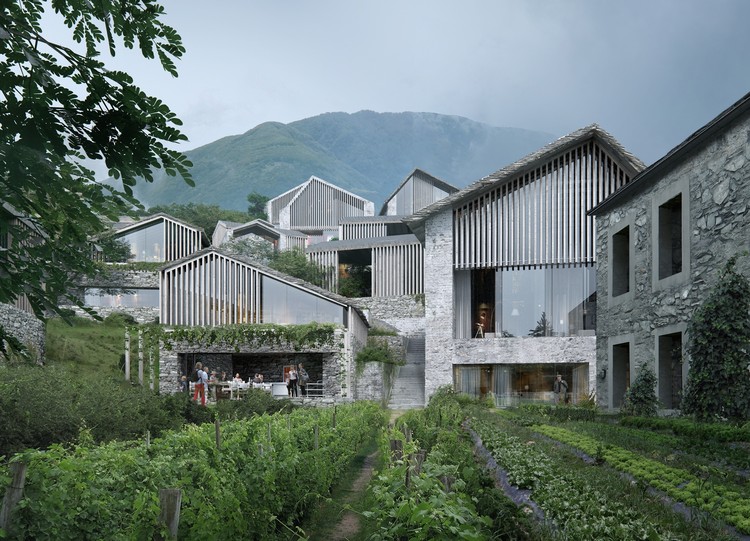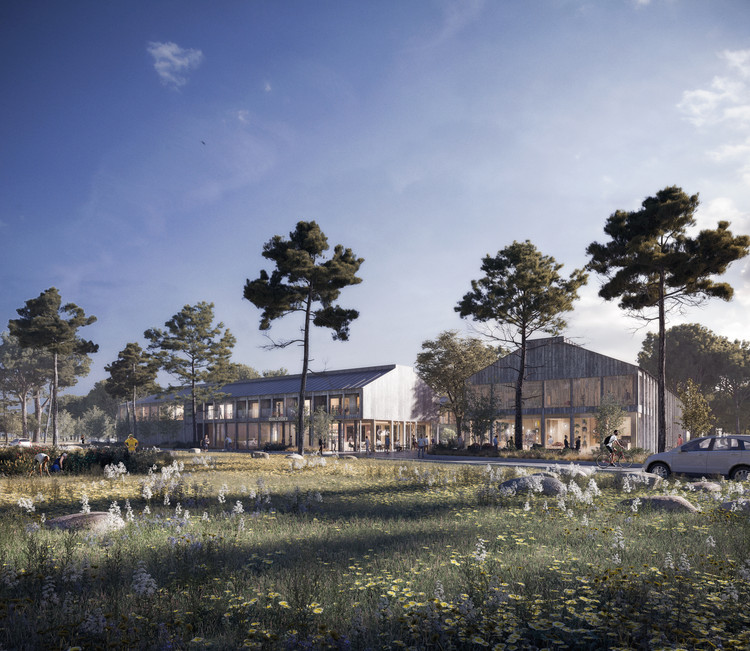As part of our partnership with the 27th World Congress of Architects, we are sharing here an interview with architect Francis Kéré, a speaker confirmed for the UIA2021RIO, conducted by architect Miguel Pinto Guimarães.
News
Francis Kéré: "I Am Privileged to Be Able to Serve My Community"
Mighty Buildings Creates New 3D Printed ADU in San Diego

Construction technology company Mighty Buildings has completed a new 3D-printed Accessory Dwelling Unit in San Diego, California. The company recently launched with the aim of using 3D printing and robotic automation to build more affordable and sustainable homes. Their pilot project, the Mighty Duo B, comprises two modular units that took eight total weeks from fabrication to assembly on site.
Tiny House Made from Recycled Materials Begins Construction in Bali

Bali-based Stilt Studios has begun construction on a new prefabricated tiny house made out of recycled Tetra Pak cartons. The team has also launched a Kickstarter campaign to create awareness for the use of recycled materials. Designed to promote local, circular economies, the first prototype is now being built and sales of the tiny house will commence in October this year.
How to Future-Proof Our Cities? 4 Key Initiatives to Increase Resilience

Our cities, vulnerable by nature and design, have generated the biggest challenge that humankind has to face. With the vast majority of the population expected to settle in urban agglomerations, rapid urbanization is going to raise the issue of adaptability with future social, environmental, technological and economic transformations.
In fact, the main problematic of the decade questions how our cities will cope with fast-changing factors. It also looks into the main aspects to consider in order to ensure long-term growth. In this article, we highlight major points that help future-proof our cities and create a livable, inclusive and competitive fabric that adapts to any unexpected future transformation.
Bendigo Law Courts Designed as Iconic Landmark in Australia

John Wardle Architects have designed the new Bendigo Law Courts in Australia, and the team's proposal is currently on public exhibition. The project will be the first in Victoria to feature multiple specialist courts in one location. The city's future law building aims to transform the delivery of justice in Bendigo and Loddon Mallee, an area extending from Kyneton to Mildura throughout the north-west of Victoria.
Photographing Brutalist Architecture (and Its Evolution) in Barcelona

Rodolfo Lagos shared a series of photographs capturing the Brutalist architecture of Barcelona, illustrating how the movement has evolved in this iconic city.
Eastern Bloc Buildings: Monolithic Housing Blocks

This article is part of "Eastern Bloc Architecture: 50 Buildings that Defined an Era", a collaborative series by The Calvert Journal and ArchDaily highlighting iconic architecture that had shaped the Eastern world. Every week both publications will be releasing a listing rounding up five Eastern Bloc projects of certain typology. Read on for your weekly dose: Monolithic Housing Blocks.
Renzo Piano's Genoa Bridge Opens to Traffic

Designed by Renzo Piano, Genova San Giorgio, the new viaduct over the Polcevera has been inaugurated. Created after the tragic collapse of the Morandi Bridge in 2018, the new bridge in place will be open to traffic starting August 5, 2020.
Foster + Partners' Apple Store Opens in Sanlitun Quarter, Beijing

Foster + Partners has completed and reimagined the Apple store in Sanlitun, an urban quarter in Beijing, China. Originally built in 2008, Apple’s first store in China has relocated, in proximity to the older building, taking on more social aspects, and generating a “new dialogue with the surrounding pedestrian streets, addressing the large open square that is a social focus for the district”.
Oppenheim Creates Secluded Swiss Resort to Frame Mountain Views

Oppenheim Architecture has completed the design for a resort in Ticino, southern Switzerland. Overlooking Lago Maggiore, the resort arises from the varied landscape of Alpine peaks and dense forests. Comprising over 100 private residences, a boutique hotel, and spa and wellness environment, the design embraces the region's unique landscapes and ecologies across three sites.
Architecture of the Afterlife: Crypts, Tombs and Mausoleums

Mortality defines both architecture and human experience. Throughout time, funerary structures have been designed across societies and civilizations to ground personal and shared beliefs. The idea of the afterlife shapes how these buildings are made, from symbolic monuments to vast tombs and crypts. Now a new range of modern architecture has been designed for remembrance and reflection.
“A Building Should Be Nurturing and Protect People Within”: In conversation with Douglas Cardinal

Douglas Cardinal (b. 1934) is a visionary indigenous Canadian architect based in Ottawa, Ontario. He grew up in Red Deer, Alberta. His mother, who was of German origins, loved painting and music, and both became his passions as well during his years at a Catholic boarding school. In 1953, he started studying architecture at the University of British Columbia in Vancouver, but was forced to leave two years later due to his outspoken opposition to follow rigid geometry of the Bauhaus and International Style models, championed by his professors. He wanted to create buildings that would respond to nature and the organic rhythm of life, drawing from his childhood experience of being intimate with nature.
Cristina Veríssimo and Diogo Burnay Appointed Curators of 2022 Lisbon Architecture Triennale

The Lisbon Architecture Triennale has announced the appointed Chief Curators for their 6th edition, which will take place in 2022. The architects Cristina Veríssimo and Diogo Burnay were chosen given their great professional experience in the various aspects of the discipline that includes education, academic, and project activity in Portugal and abroad. The duo will be dedicating three years to preparing the Triennale 2022, beginning with an exploratory period for research, a team definition phase, a phase of structuring the programme design, ending with its implementation.
How to Bend Wood

From its starting to point as a tree to its product form as a beam or piece of furniture, wood used in architecture and interior design goes through several stages and processes. A renewable resource and popular traditional building material, wood is also often cited as a promising construction material of the future, one that is suitable for the new demands of sustainability. But unlike concrete, whose molds can create even the most complex curves, wooden architecture most commonly uses straight beams and panels. In this article, we will cover some techniques that allow for the creation of curved pieces of wood at different scales, some of which are handmade and others of which seek to make the process more efficient and intelligent at a larger scale.
WTA, In Praise of Shadows and Land Arkitektur Imagine Low Impact Headquarters for Housing Association in Sweden

Waugh Thistleton Architects or WTA has won an international design competition in collaboration with In Praise of Shadows and Land Arkitektur, to deliver the new head office of Gotlandshem, the national housing association of the Swedish island of Gotland in Visby, Sweden. The project, low carbon, and low impact building will be a multifunctional place, providing a healthy hub for businesses, accessible by the whole community.
MVRDV Wins Competition to Design the Masterplan of the Ettlinger Tor Area in Karlsruhe, Germany
.jpg?1596440556)
Proposing a reflective “floating garden” to counterpoint the existing absolutist castle, MVRDV has won the competition for the masterplan of the Ettlinger Tor area in Karlsruhe, Germany, taking joint-first place alongside Max Dudler Architekten. Inspired by the historical fabric of the city, the project imagines a new composition, blurring divisions, and bringing more greenery to the area.
Where Will Innovation in Architecture Come From Next?

Now more than ever, architecture is in need of innovation. The pandemic has made us fundamentally rethink the functioning of our cities, public spaces, buildings, and homes. Meanwhile, the recent Black Lives Matter and racial justice protests have us questioning architecture’s complicity in broader socioeconomic issues. These challenges are pressing, and we cannot put off changing architecture any longer.
Socially-Organized Housing in Latin America: The Experience of Christopher Alexander

The series of articles developed by Nikos A. Salingaros, David Brain, Andrés M. Duany, Michael W. Mehaffy and Ernesto Philibert-Petit researches the peculiarities of social housing in Latin America. This time, the authors focus on the role of participation in design processes and in the construction of a healthy urban fabric based on the experience of Christopher Alexander.
The Future of Universities, Offices and Cities: Highlights From Digital Futures 2020

Like most functions in recent months, this year’s Digital FUTURES, which is held annually since 2011 at Tongji University in Shanghai, had to move online due to the pandemic. The organizers took this as an opportunity to give the event a global dimension, turning the festival into what they rightfully call the most significant worldwide event for architectural education ever staged, with a 24/7 display of workshops, lectures and panel discussions involving some of the most prominent architects and educators. Here is an overview of the festival, together with a selection of lectures from Digital FUTURES World.
FCBStudios' Net Zero Carbon Timber Workspace in London, Receives Planning Commission

A new six-story net-zero carbon office development in Vauxhall, London, UK has been granted planning commission by the city council to move further. Designed by FCBStudios, the timber workspace named Paradise, will transform an abandoned site on old Paradise street, and replace the existing disused roastery.












































.jpg?1596440410)

.jpg?1596440577)
.jpg?1596440379)









.jpg?1596100203)
.jpg?1596100176)

.jpg?1596100270)